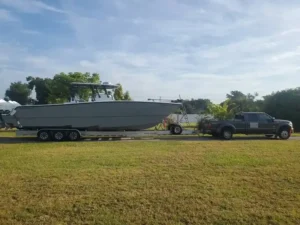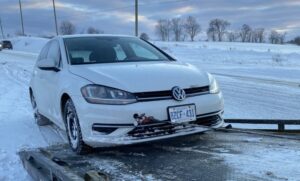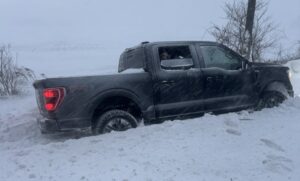Moving can be one of life’s most stressful events, and for many in Ontario, including those in the Aurora area, transporting a vehicle along with their household goods is a common challenge. While professional towing services like Pars Towing are always available for complex or emergency situations, sometimes a U-Haul tow dolly offers a practical and cost-effective solution for DIY moves. But for first-timers, the prospect of loading a car onto a U-Haul Tow Dolly can seem daunting. This comprehensive guide will walk you through every step, ensuring a safe and successful loading process, whether you’re moving across town or across provinces.
- Learn More >>>>How To Open a Locked Car Door Without a Key
How to Load a Car onto a U-Haul Tow Dolly
1. Understanding the U-Haul Tow Dolly: Your Essential Moving Companion
Before you even think about loading, it’s crucial to understand what a U-Haul Tow Dolly is and how it functions. A tow dolly is a two-wheeled trailer designed to lift the front wheels of a vehicle off the ground, allowing the rear wheels to remain on the road. This makes it ideal for front-wheel-drive vehicles, though with proper preparation, some rear-wheel-drive cars can also be transported this way. U-Haul’s tow dollies are known for their ease of use and accessibility, but proper setup and loading are paramount for safety.
Key Features of a U-Haul Tow Dolly:
- Integrated Ramps: These are essential for driving your vehicle onto the dolly.1
- Wheel Straps: These secure your vehicle’s front tires to the dolly, preventing movement during transit.2
- Safety Chains: These provide an additional layer of security, connecting your towed vehicle to the tow dolly.3
- Coupler: This connects the tow dolly to your towing vehicle’s hitch ball.
- Lights and Wiring: For safe road travel, ensuring your towed vehicle’s lights are visible.
2. Pre-Loading Preparations: Safety First!
Thorough preparation is the cornerstone of a safe tow. Skipping these vital steps can lead to damage, accidents, or even legal issues.
2.1. Inspecting Your Tow Dolly and Towing Vehicle
Before you even think about connecting, give everything a once-over.
- U-Haul Tow Dolly Inspection:
- Tires: Check tire pressure on the dolly. Ensure they are inflated to the recommended PSI, usually found on a sticker on the dolly itself. Look for any visible damage, bulges, or excessive wear.
- Lights and Wiring: Test all lights (brake lights, turn signals) on the dolly. Ensure the wiring harness is intact and free of frays or damage.
- Ramps: Verify ramps are clean, free of debris, and operating smoothly.
- Straps and Chains: Inspect the wheel straps and safety chains for any cuts, frays, or damage. Ensure the ratchets (if applicable) are functioning correctly.
- Coupler: Check for any rust or damage. Ensure it opens and closes properly.
- Grease: Apply a thin layer of grease to the hitch ball for smoother coupling and reduced wear.4
- Towing Vehicle Inspection:
- Towing Capacity: Crucially, verify that your towing vehicle’s towing capacity exceeds the combined weight of the U-Haul Tow Dolly and the vehicle you intend to transport. This information can be found in your vehicle’s owner’s manual. Overloading is extremely dangerous.
- Hitch: Ensure your hitch is securely mounted and rated for the weight you’ll be towing.
- Tires: Check the tire pressure on your towing vehicle, especially the rear tires, as they will bear additional weight.
- Brakes: Ensure your towing vehicle’s brakes are in excellent condition.
- Transmission Fluid: Top off if necessary, especially if you have an automatic transmission, as towing puts extra strain on it.
- Learn More >>>>How to Change a Tire: A Step-by-Step Guide
2.2. Preparing the Vehicle to be Towed
The car you’re loading also needs a little attention.
- Remove Loose Items: Clear out any loose items from the interior and trunk that could shift or become projectiles during transit.
- Check Fluid Levels: Ensure all fluid levels (oil, coolant, power steering fluid) are at appropriate levels, especially if you’ll be towing a rear-wheel-drive vehicle with the driveshaft connected.
- Inflate Tires: Ensure all four tires on the towed vehicle are properly inflated.
- Check Parking Brake: Make sure the parking brake on the towed vehicle is fully released before loading.
- Power Steering and Braking: Be aware that without the engine running, your towed vehicle will have no power steering or power brakes, making it harder to maneuver on and off the dolly.
3. Connecting the U-Haul Tow Dolly to Your Towing Vehicle
This is the first physical connection, and it needs to be done right.
- Positioning: Back your towing vehicle up to the U-Haul Tow Dolly. Aim to align the hitch ball directly over the dolly’s coupler. Take your time, making small adjustments.
- Lowering the Dolly: Use the jack on the dolly (if equipped) or manually lower the dolly onto the hitch ball.
- Securing the Coupler: Once the dolly is seated on the ball, close the coupler latch securely. There should be a satisfying “click,” and often a secondary locking mechanism. Tug upwards on the dolly to ensure it’s firmly attached.
- Attaching Safety Chains: Cross the safety chains under the tongue of the dolly and attach them to the designated chain hooks on your towing vehicle’s hitch or frame. Crossing them provides a “cradle” in case of a coupler detachment.
- Connecting Electrical Wiring: Plug the dolly’s electrical connector into your towing vehicle’s trailer light receptacle. Test the lights again (brake lights, turn signals) to confirm they are working correctly.
4. Positioning and Loading the Car onto the U-Haul Tow Dolly
This is the most critical step and requires precision and caution.
4.1. Selecting a Safe Loading Location
Choose a flat, level, and firm surface for loading. Avoid inclines, soft ground, or busy areas. Ample space around the vehicles is essential.
4.2. Aligning the Car with the Dolly
- Straight Approach: Drive the car you’re loading slowly and carefully towards the U-Haul Tow Dolly. Aim to align the front tires squarely with the center of the ramps.
- Spotter Recommended: If possible, have a trusted spotter guide you. They can stand to the side (never directly in front or behind) and give clear hand signals.
- Slow and Steady: Drive extremely slowly. A little too much gas can send your car flying off the ramps.
4.3. Driving Onto the Dolly
- Controlled Ascent: Gently drive the car up the ramps. You’ll feel a slight bump as the wheels clear the top of the ramps and settle into the wheel cradles on the dolly.
- Proper Placement: Ensure the front tires are fully seated in the wheel cradles. They should be snug and not overhanging the edges.
- Parking Brake and Transmission: Once the car is in position, engage the parking brake firmly. For automatic transmissions, place the car in “Park.” For manual transmissions, place it in gear.
- Learn More >>>>HOW TO JUMP START A NISSAN LEAF
4.4. Securing Rear-Wheel-Drive Vehicles (Important Consideration)
If you are towing a rear-wheel-drive vehicle, you generally have two options:
- Disconnecting the Driveshaft: This is the safest and recommended method for longer distances, as it prevents transmission damage. Consult your vehicle’s manual or a mechanic for instructions. Pars Towing can also advise on this.
- Removing Fuses: For some RWD vehicles, removing specific fuses (e.g., for the fuel pump or ignition) can prevent the transmission from engaging during towing. Again, consult your owner’s manual.
- Towing Backward: While some sources suggest towing RWD vehicles backward (rear wheels on dolly, front wheels on ground), this is generally not recommended by U-Haul or experts due to steering instability. Stick to the driveshaft disconnection or fuse removal if possible.
5. Securing the Vehicle to the U-Haul Tow Dolly with Straps and Chains
This is where your car becomes one with the dolly for the journey.
5.1. Attaching Wheel Straps
- Positioning: Place the wheel straps over the center of each front tire. Ensure the straps are flat and not twisted.
- Routing: Route the ends of the straps through the ratcheting mechanisms on the dolly.
- Tightening: Begin tightening the straps using the ratchet. Ensure both sides are tightened evenly. You want the straps to be extremely snug, compressing the tire slightly.
- Check for Slippage: Once tight, try to manually rock the tire to ensure there’s no movement.
5.2. Attaching Safety Chains
- Route and Connect: Attach the safety chains from the U-Haul Tow Dolly to a solid, structural part of the towed vehicle’s frame or lower control arms. Avoid attaching to suspension components that might move.
- Sufficient Slack: Leave just enough slack in the chains to allow for turns without becoming taut, but not so much that they could drag on the ground.
- Redundant Security: These chains are your last line of defense should the wheel straps fail.
5.3. Final Checks Before Departure
- Walk Around: Do a complete walk-around of your entire setup: towing vehicle, tow dolly, and towed car.
- Re-check All Connections: Verify hitch, safety chains, electrical connection, wheel straps, and towed vehicle safety chains.
- Lights: Test all lights again (turn signals, brake lights, running lights).
- Clearance: Ensure there is adequate ground clearance for the towed vehicle.
- Steering Wheel Unlocked (Front-Wheel Drive): For front-wheel-drive vehicles where the rear wheels are on the ground, ensure the steering wheel is unlocked. This allows the rear wheels to track properly around corners.
- Steering Wheel Locked (Rear-Wheel Drive, Towed Backward – Not Recommended): If, against advice, you are towing a rear-wheel-drive vehicle backward, the steering wheel must be locked straight ahead to prevent instability. This is why Pars Towing and other professionals strongly advise against this method.

- Learn More >>>>How do I get a tow truck?
6. On the Road: Driving with a U-Haul Tow Dolly
Driving with a tow dolly requires a significant adjustment to your driving habits.
- Reduced Speed: Drive slower than usual. Adhere to posted trailer speed limits.
- Increased Braking Distance: Your stopping distance will be significantly longer. Anticipate stops and brake gently.
- Wider Turns: Make wider turns to accommodate the extra length of your setup.
- Lane Changes: Plan lane changes well in advance and be deliberate.
- Regular Checks: Pull over periodically (every hour or so) to check the straps, chains, and tire pressure on both the dolly and the towed vehicle. Straps can loosen due to road vibrations.
- Hills: Ascend and descend hills carefully. Downshift on descents to use engine braking and avoid overheating your brakes.
- Wind and Weather: High winds or adverse weather conditions (rain, snow) will amplify the challenges of towing.5 Be extra cautious or pull over if conditions are severe.
7. Unloading the Car from the U-Haul Tow Dolly
Once you’ve arrived at your destination, unloading is essentially the reverse of loading.
- Flat, Level Surface: Again, choose a safe, flat, and level area.
- Secure Towing Vehicle: Keep your towing vehicle in “Park” with the parking brake engaged.
- Remove Safety Chains: Detach the safety chains from the towed vehicle.
- Release Wheel Straps: Carefully release the tension on the wheel straps using the ratchet mechanism.6 Unthread the straps and remove them from the tires.
- Slow Descent: Gently drive the car backward off the ramps. Take your time, watching your mirrors.
- Clear the Dolly: Once the car is completely off the dolly, you can then disconnect the U-Haul Tow Dolly from your towing vehicle.
When to Call the Professionals: Pars Towing in Aurora and Ontario
While a U-Haul tow dolly can be a convenient solution, there are times when professional assistance is not just helpful, but necessary.
- Complex or Heavy Vehicles: If your vehicle is particularly heavy, has complex drive systems (e.g., all-wheel drive, specific luxury vehicles), or if you’re unsure about the driveshaft disconnection, it’s best to call in experts.
- Long-Distance Hauls: For very long distances, the wear and tear on a vehicle towed by a dolly can be significant. Flatbed towing, offered by services like Pars Towing, eliminates this concern entirely.
- Damage or Breakdown: If your car is damaged or has broken down, loading it onto a dolly yourself might be impossible or unsafe.
- Peace of Mind: Sometimes, the sheer stress of a DIY move is enough reason to hand over the vehicle transport to experienced professionals. Pars Towing, serving the Aurora area and broader Ontario, has the specialized equipment and expertise to handle any vehicle towing need, ensuring your car arrives safely and without a hitch.
- Learn More >>>>Folding Car Tow Dolly
Conclusion
Loading a car onto a U-Haul Tow Dolly is a manageable task, provided you approach it with careful planning, attention to detail, and a commitment to safety. By following these steps, inspecting your equipment thoroughly, and driving cautiously, you can successfully transport your vehicle to your new destination. However, remember that for any situation where you feel unsure, or for more complex towing needs, the reliable and professional services of Pars Towing are just a call away, ready to assist you anywhere in Ontario, including your local Aurora community. Safe travels!







